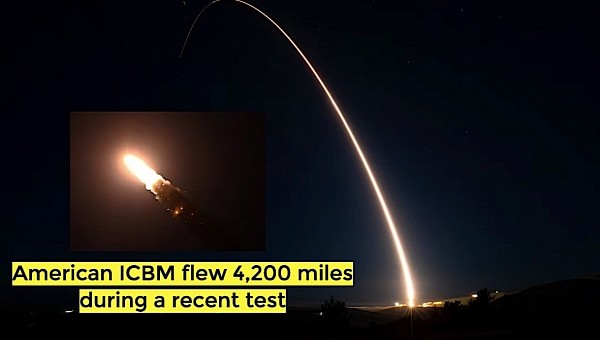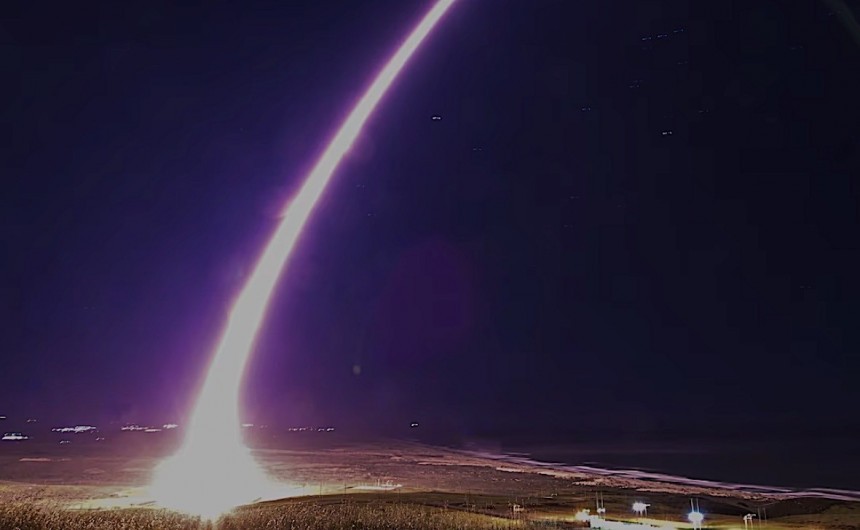For more than a week or so, the United States of America has been at war with mostly unidentified flying objects crossing into its own, but also Canadian, air space. It’s a sort of asymmetrical war, with the country’s most advanced fighter jets going after what appear to be balloons of some sort, that pose no actual physical threat to any of the countries, but may be used to gather sensitive information about what's on the ground.
Naturally, people are not really at ease with fifth-generation fighter aircraft firing live missiles at real targets in the skies above their heads. The lack of factual information as to what is actually happening contributes to making some folks jittery. Some other, not necessarily related actions taken by various military branches serving U.S. needs don’t help either.
Over the weekend, the most recent military branch to be created, the U.S. Space Force, announced the launch of a Minuteman III intercontinental ballistic missile (ICBM) as part of a test meant to show the country’s enemies “that the United States’ nuclear deterrent is safe, secure, reliable, and effective.”
The Minuteman is a land-based ICBM, meaning it takes off from ground-based facilities, and came about in the early 1960s, at a time when the first Cold War was inches close to degenerating into a very hot thermonuclear one. It was designed to launch from U.S. soil and carry nuclear warheads to distances going as far as 6,000 miles (9,600 km), and it's presently in the process of being replaced with the much fancier Sentinel system.
Now, American forces routinely carry such ICBM tests, either detonating some non-nuclear warhead or just taking to the sky to test some new technology. That’s exactly what happened last weekend, when the Minuteman III was launched from the Vandenberg Space Force Base, California, to test a new reentry vehicle.
The missile left California and headed out to a distance of 4,200 miles (6,700 km), reaching the Marshall Islands. No exact details on the reentry vehicle being tested were provided, this being a military affair and all.
Of course, the Space Force hints this firing of the ICBM is in no way related to the war waging in the skies above. As per its own estimates, Minutemen were fired over the years at least 300 times, each time to test something or to prove the nation's capabilities to potential foes.
Yet, the timing couldn’t be more right. China has been known to let surveillance balloons drift over the continental U.S. before. No exact numbers about the most recent incursions are known, but as a side note, during the Donald Trump administration, they’ve been detected at least three times. Never before (to our knowledge, at least) did the U.S. actively take action against them until now.
On its end, China points the finger the other way, saying on Monday that Americans sent their own balloons over the Asian country at least ten times since January 2022.
Over the weekend, the most recent military branch to be created, the U.S. Space Force, announced the launch of a Minuteman III intercontinental ballistic missile (ICBM) as part of a test meant to show the country’s enemies “that the United States’ nuclear deterrent is safe, secure, reliable, and effective.”
The Minuteman is a land-based ICBM, meaning it takes off from ground-based facilities, and came about in the early 1960s, at a time when the first Cold War was inches close to degenerating into a very hot thermonuclear one. It was designed to launch from U.S. soil and carry nuclear warheads to distances going as far as 6,000 miles (9,600 km), and it's presently in the process of being replaced with the much fancier Sentinel system.
Now, American forces routinely carry such ICBM tests, either detonating some non-nuclear warhead or just taking to the sky to test some new technology. That’s exactly what happened last weekend, when the Minuteman III was launched from the Vandenberg Space Force Base, California, to test a new reentry vehicle.
Of course, the Space Force hints this firing of the ICBM is in no way related to the war waging in the skies above. As per its own estimates, Minutemen were fired over the years at least 300 times, each time to test something or to prove the nation's capabilities to potential foes.
Yet, the timing couldn’t be more right. China has been known to let surveillance balloons drift over the continental U.S. before. No exact numbers about the most recent incursions are known, but as a side note, during the Donald Trump administration, they’ve been detected at least three times. Never before (to our knowledge, at least) did the U.S. actively take action against them until now.
On its end, China points the finger the other way, saying on Monday that Americans sent their own balloons over the Asian country at least ten times since January 2022.












